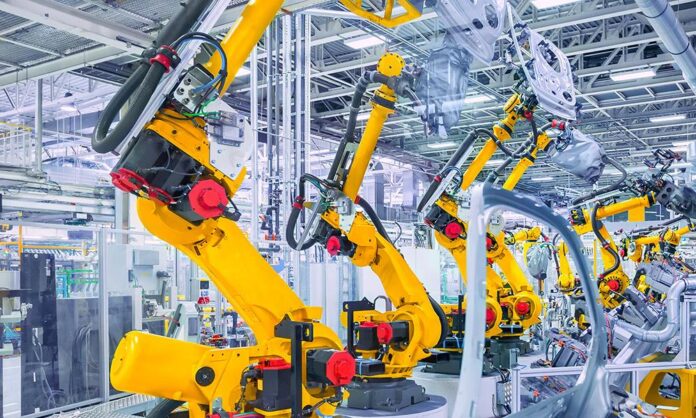It’s a great time to be part of the manufacturing world.
- Value added in the manufacturing market is projected to reach $14.83tn in 2023 (Statista)
- The number of manufacturing employees will likely surpass 238 million in 2023 (Statista)
Best of all, new technologies and trends are emerging in manufacturing. These trends are helping manufacturers to produce better products, boost efficiency levels, and make important cost savings—but what are these trends?
Below, you’ll find a list of ten exciting manufacturing trends that you need to know about, whether you own a manufacturing company or are simply on an industry watch mission.
1. Laser Engraving
Laser engraving has been around for a while. However, it’s only over the past decade that it’s truly exploded in popularity throughout the manufacturing industry.
Now, countless different factories are using laser engraving machines for finishing operations. This happens at the end of the manufacturing process once all the parts have been assembled and completed. During the finishing operations, laser engraving machines will then be used to add ‘finishing’ touches, such etched logos. Essentially, the process of laser engraving is the cherry on top of the cake.
When it comes to the materials, laser engraving machines can engrave almost all possible materials. This includes metals, woods, and plastics. For instance, if you own a manufacturing company that primarily manufactures wooden products, then you’d benefit from a metal laser engraver.
According to Expert Market Research, the laser engraving trend in manufacturing shows no sign of slowing down, as the market is assessed to grow at a compound annual growth rate of 8.3% between 2023 and 2028. Knowing this information, it’s not surprising that countless manufacturers are investing in laser engraving machines or upgrading their existing models.
Check out: What Is PCB Fabrication? A Brief Introduction
2. Traceability
Traceability is another hugely popular trend in manufacturing. Simply put, traceability is the ability to track a product from the beginning of the manufacturing process to the moment that it’s shipped. This enables greater accuracy, fewer errors, and cost savings. Typically, the way this is done is through barcoding, radio frequency identification (RFID) systems, product traceability software, or a combination of all three.
3. AI Automation
By now, you’ve heard all about AI (Artificial Intelligence). It seems as though AI is taking over every aspect of working life—including manufacturing. This isn’t something to be scared of, though. In fact, you should be very excited if you’re a manufacturing company owner, as AI automation is great when it comes to improved efficiency and cost savings (which is why countless factories are now using it).
Essentially, AI is being used to automate complex tasks in manufacturing that previously took too long to do, from product assembly to processing. As a result, manufacturing companies don’t have to hire as many employees and aren’t reliant on as many manual processes across their factory floors.
4.Eco-Friendliness and Sustainability
Ever since 2020, there has been a huge shift in manufacturing towards sustainability. All of the world’s biggest companies, from Apple to Microsoft, have implemented more sustainable practices and supply chains. Naturally, this has trickled down to other businesses—even small-scale manufacturers.
Now, what you’re seeing is manufacturers using more natural resources, recycling waste, eliminating pollution, and much more. Not only is this great for them, but it’s also great for the environment. Everybody wins.
5. Remote Monitoring
Remote monitoring is a popular manufacturing trend at the moment. It’s the process of analysing production processes and machinery from a distance, which ultimately allows:
- Errors to be spotted ahead of time
- Working environments for human employees to be made safer
If you want to do remote monitoring for your factory, you’ll need to wirelessly connect your production lines to cloud-based technology. This way, everything can be monitored remotely from your preferred devices.
6. Digital Twins
Digital twins are software models that represent the physical assets used in the manufacturing process. Therefore, what this enables manufacturers to do is monitor and test their processes through the software instead of in real life. As a result, potential flaws can be uncovered much faster.
7. 3D Printing
3D printing has gradually become a key part of modern-day manufacturing. Now, 3D printing is used for all kinds of things, such as producing car parts and medical devices.
Heading into the future, many expect that 3D printing will become the dominant form of manufacturing, but that’s still quite far away.
8. Extended Reality Training
Extended reality training enables is training provided to manufacturing employees through virtual reality (VR) and mixed reality (MR). Essentially, employees can train to do their roles in a digital world that replicates the real physical world. It’s a crazy concept that will soon be the norm, as many manufacturers have already caught on to its effectiveness.
9. The Rise of ‘Smart Factories’
Smart factories are manufacturing factories that use advanced technologies for data collection, automated manufacturing, and lots more. For example, Tesla’s gigafactories are classed as ‘smart factories’ because of the sheer volume of data collection and automation that takes place across them.
10. Reshoring
Lastly, there’s the reshoring trend. As the name suggests, reshoring is when you stop manufacturing products abroad and bring the manufacturing of goods back to your original country.
Let’s say that your products have been manufactured in China for decades but you decide to bring the manufacturing back to the country you operate in. This is an example of reshoring.
Check out: Aluminum PCBs: Basics of Aluminum Printed Circuit Board

